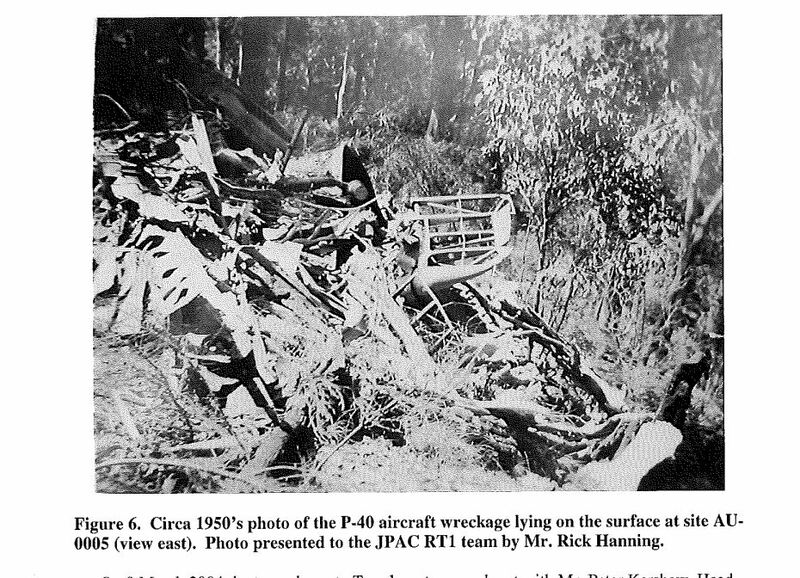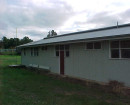Back to search results
KITTYHAWK P-40 PLANE CRASH SITE
PLANE TRACK BAW BAW, BAW BAW SHIRE
KITTYHAWK P-40 PLANE CRASH SITE
PLANE TRACK BAW BAW, BAW BAW SHIRE
All information on this page is maintained by Heritage Victoria.
Click below for their website and contact details.
Victorian Heritage Inventory
-
Add to tour
You must log in to do that.
-
Share
-
Shortlist place
You must log in to do that.
- Download report

Images of site, c.1950s presented to JPAC by Mr Rick Hanning (included in JPAC report, May 2004).

On this page:
Statement of Significance
What is significant?
How is it significant?
Why is it significant?
Show more
Show less
-
-
KITTYHAWK P-40 PLANE CRASH SITE - History
This record is likely to relate to the wreck of a US (United States) P-40E Kittyhawk flown by an American pilot, Captain Joseph Potter McLaughlin, who went missing in action in March 1942.
The crash site was discovered on 29 December 1948, and on 01 January 1949 the RAAF Base East Sale visited the site and recovered human remains and aircraft identification plates. Parts of the plane have been salvaged over time.
Captain Joseph McLaughlin was an American Pilot who was deployed in Australia to test newly assembled P-40 Kittyhawks. The final months of Captain McLaughlin’s service in 1942 were not extensively documented, and the association between the crash site Captain McLaughlin have been the subject of some research.Captain McLaughlin arrived in Australia in 1942, and was based in Melbourne. He was working with the RAAF to test newly assembled P-40 Kittyhawk planes. The plane at the site is confirmed to be Kittyhawk P-40 41-5526. It was constructed in America, served in the Philippines in 1941 and was then serviced to Australia.Captain McLaughlin was assigned a special mission to deliver a letter to Prime Minister Curtain in March 1942 containing details of US President Roosevelt’s intentions regarding US forces in the Pacific. Captain McLaughlin was considered a suitable candidate given his experience on the Kittyhawk. Ammunition discovered at the crash site indicates that he was assigned for transfer to the RAAF at No 4 Aircraft Depot at Laverton.JPAC investigated the site in 2004. It is their assessment that Captain McLaughlin went missing in flight, after take-off from Canberra from an undisclosed location. He was reported missing on 19 March 1942. Archaeologists recovered personal effects associated with the P-40 Kittyhawk. This investigation confirmed the identification of McLaughlin as the pilot of the aircraft.Captain McLaughlin was given a full military funeral service on 10 April 2006 and buried at Section 60, Plot 649, Arlington National Cemetery, Washington.
A Royal Australian Air Force (History and Heritage Branch - Air Force Headquarters) report on the wreck (June 2021) concluded that: the discovery of the crash site in 1948 and subsequent RAAF decisions were appropriate and correct at the time. Significant research has validated the 1949 DPS Casualty Section decision that there are no missing RAAF pilots or Kittyhawk aircraft in the Walhalla area: nor is there evidence of two crash sites at Walhalla. There is evidence pointing to the crash having occurred in 1942 or soon after. No other evidence has been offered regarding missing RAAF Kittyhawks or pilots. Subsequent administrative issues with RAAF statements, Kittyhawk documentation or actions since 1949 have not altered the facts in this case.
The site is of local archaeological significance.
Updated on 23/05/2022.Heritage Inventory Description
KITTYHAWK P-40 PLANE CRASH SITE - Heritage Inventory Description
Walhalla, VIC. c. March 1942. The crash site of a USAAF P-40 Kittyhawk aircraft in mountainous terrain near Walhalla. The aircraft was operating between Laverton and Canberra. The aircraft was in flight to Melbourne returning from a special mission when it crashed in severe weather. Captain Joseph Mclaughlin was killed in the crash. McLaughlin was on Detached Service in Australia. The wreck was discovered on 29 December 1948. The RAAF Base East Sale visited the site and recovered human remains and aircraft identification plates. Parts of the plane have been salvaged since its discovery in January 1949. The site was investigated by JPAC (Joint POW/MIA Accounting Command) in 2004. Archaeologists recovered personal artefacts associated with the P-40 Kittyhawk. This investigation confirmed the identification of Captain Joseph McLaughlin as the pilot of the aircraft. During the JPAC work a local gave the investigating team a wristwatch body he has recovered from soil embedded in the engine block at the crash site in the 1950s. Inscribed on the watch back is 'JP MCLAUGHLIN; CAPT;AC'. In 2003 a team from the U.S Army Central Identification Laboratory-Hawaii surveyed the site and recorded that the site had been thoroughly scavenged by local residents and only very small fragments of aircraft debris remained. The evidence of a crash site was limited to a very small crater in the side of the mountain and a sparse debris field of very small wreckage extending downslope from the crater. Materials visible on site included small, unidentifiable, melted aluminium pieces; rusted iron and steel fragments and glass shards.
-
-
-
-
-
KITTYHAWK P-40 PLANE CRASH SITE
 Victorian Heritage Inventory
Victorian Heritage Inventory
-
-







